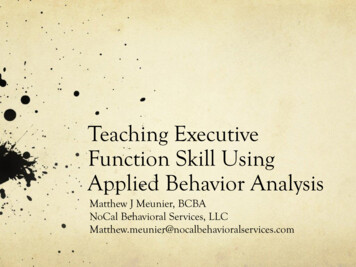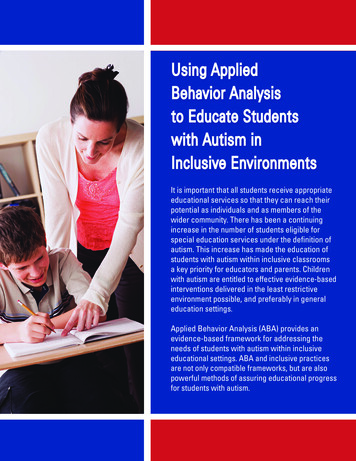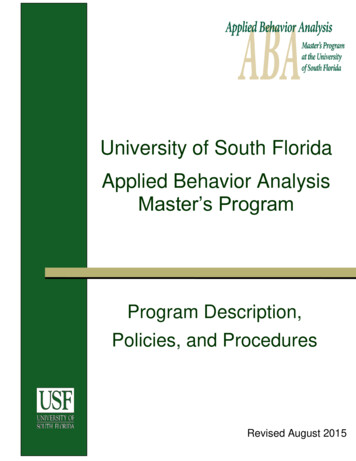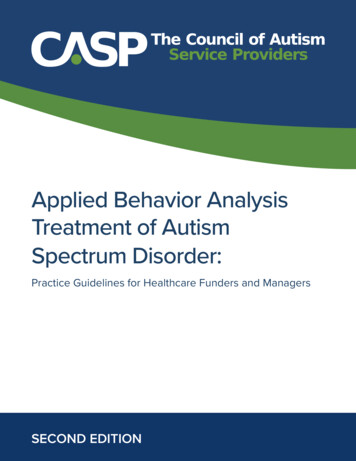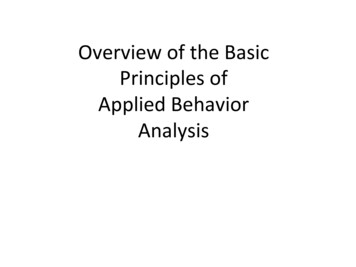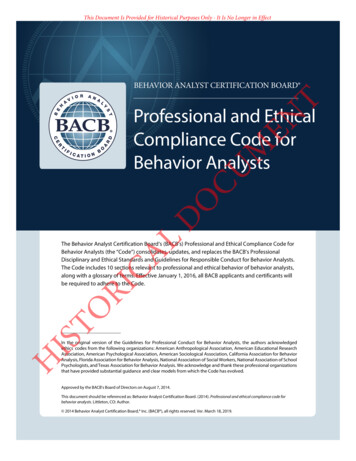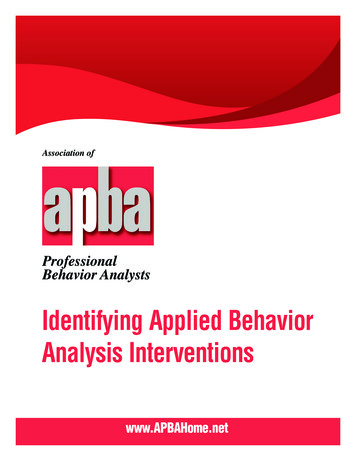
Transcription
Association ofProfessionalBehavior AnalystsIdentifying Applied BehaviorAnalysis Interventionswww.APBAHome.net
Association ofProfessionalBehavior AnalystsThis white paper was approved by the Board of Directors of the Association ofProfessional Behavior Analyts (APBA) on July 25, 2016 and updated in May2017. It represents the position of APBA, a non-profit membership organizationwhose mission is to promote and advance the science-based practice ofapplied behavior analysis (ABA), and is intended to serve as a resource forthose with an interest in that practice. Electronic and/or hard copies may bemade for personal, educational, or policymaking purposes, but not forcommercial use. All copies must include this notice on the first page. Any otheruse or distribution requires advance written permission from APBA; requestsshould be sent to info@apbahome.net or APBA, 3443 Camino del Rio South,Suite #210, San Diego, CA 92108.Copyright 2017 by the Association of Professional BehaviorAnalysts, all rights reserved2
Table of ContentsExecutive Summary . . 4Underlying Scientific Concepts and Methods . 6Origins of Applied Behavior Analysis 12Defining Features of ABA 16Professional Practice of ABA .17Summary . . 21References . 233
Executive SummaryDemand for applied behavior analysis (ABA) services has accelerated rapidlysince the early 1990s. Although it is only one of many areas of application, much ofthe increase has been in the realm of interventions for individuals diagnosed withautism spectrum disorder (ASD). Families of people with ASD have played a majorrole in advocating for public policies to increase the availability of – and funding for– ABA services. Those efforts have produced many benefits; however, theincreased demand and funding have also spawned widespread confusion,misunderstandings, and misrepresentations regarding behavior analysis, itsapplications, and qualifications for practicing ABA professionally.This white paper aims to dispel some of the most common misconceptions aboutbehavior analysis and to help consumers, members of various professions,funders, and policymakers differentiate ABA interventions from others. It presentskey facts about the defining features of the discipline with supportingdocumentation: Behavior analysis is a natural science with concepts, research methods,and principles (natural laws of behavior) that distinguish it from thesocial sciences. The applied branch of the discipline – ABA – originated as a blend of theexperimental analysis of behavior and information about humandevelopment. From the beginning, ABA incorporated naturalistic as wellas structured intervention techniques implented in a variety of everydaysettings. Abundant scientific research documents the effectiveness of a largearray of ABA procedures for building useful skills and reducing problembehaviors in people with and without specific diagnoses.continued on next page1 The term “intervention” is used throughout the paper to mean any procedures that are designed to changebehavior. In some contexts (such as healthcare), “treatment” is often used in place of “intervention.”4
Executive Summary continued The features of ABA interventions have been defined since 1968. The practice of ABA is a profession. Well-established, accreditedcredentialing programs for practitioners of ABA are managed by thenonprofit Behavior Analyst Certification Board (BACB). Results ofextensive job analysis studies conducted by the BACB over the past 15 years, together with case law and best practices in professionalcredentialing, have served as the basis for the competencies, degrees,coursework, supervised experience, and professional examinationsrequired to obtain BACB credentials. The requirements parallel those ofmany other professions. The BACB credentials are recognized in manylaws and regulations as qualifications for practicing ABA. Genuine ABA interventions have all the defining features of ABA and aredesigned and overseen by appropriately credentialed professionals.5
Underlying Scientific Concepts and MethodsBehavior analysis is a natural science of behavior first developed by B.F. Skinnerand colleagues starting in the 1930s (Skinner, 1938, 1945, 1953; also seeMorris, Altus, & Smith, 2013). Skinner’s conceptual model focuses on howbehaviors (anything done by living organisms) affect and are affected byenvironmental events that precede and follow them closely in time (termedantecedents and consequences, respectively). Skinner and other behavioranalysts developed research methods that are uniquely suited for studyingbehavior, which occurs only at the level of the individual and involves continuousinteractions between actions and various aspects of the environment. In general,those methods involve selecting one or a few observable behavior(s), measuringoccurrences of the behavior(s) directly and repeatedly in the presence andabsence of specific environmental events that may affect the behavior(s),graphing the resulting data, and analyzing the graphed data visually todetermine if behavior changed and if that change was due to the environmentalevents (Johnston & Pennypacker, 2009; Sidman, 1960).Behavior analytic researchers employ the methods of the basic science – theexperimental analysis of behavior – to address specific research questions inexperiments that are replicated (repeated) with multiple individual participants.(The Journal of the Experimental Analysis of Behavior was founded in 1958 asan outlet for publishing findings of that new and unique science. It continues tobe the discipline’s flagship basic research journal). Data aggregated acrossmany experiments with many different participants are used to infer theexistence of functional (causal) relations between environmental variables andbehavior. Figure 1 presents one example of the application of these distinctiveresearch methods.continued on next page6
Underlying Scientific Concepts and Methods continuedFigure 1. An illustration of behavior analytic research methods using one of several types of singlecase research designs. Each dot (data point) represents the number of times a defined, observablebehavior of an individual – say, a two-word vocal utterance by a young child – was observed andrecorded during each of 25 designated time periods (sessions), indicated on the horizontal axis ofthe graph. During the sessions labelled “baseline,” no specific environmental events that mightinfluence the behavior were present. Events arranged systematically to potentially change thatbehavior – e.g., an adult giving the child a favorite toy for a few seconds immediately followingevery two-word utterance – are labelled “intervention.” The data points in Baseline 1 show that fewtwo-word utterances occurred in any of those 5 sessions (reference the vertical axis of the graph).The data points under Intervention 1 show that shortly after intervention began (session 6), twoword utterances increased and continued to do so throughout that first intervention phase. Startingin session 13 the intervention was removed, and over the next 6 sessions (Baseline 2) the numberof two-word utterances decreased to the original low level. When intervention was again put inplace in session 20, the numbers of two-word utterances increased until they stabilized (did notchange much) over the last 3 sessions of the second intervention phase. In sum, the picture of thebehavior that is represented in the graph shows that the child did not make two-word utterancesvery often during either baseline phase when the intervention was absent, but that behaviorincreased markedly when the intervention was present. That allows a logical conclusion that theincrease over baseline was likely due to the intervention and not something else, such as practiceor other events the child experienced at the same time. In most behavior analytic studies, theprocesses just described are repeated with other participants, behaviors, settings, materials, and/orinterventionists to permit multiple comparisons of data from baseline (no treatment or control)conditions and intervention (treatment or experimental) conditions. That is, studies using singlecase research designs are controlled experiments rather than anecdotal “case reports” (a commonmisconception).7continued on next page
Underlying Scientific Concepts and Methods continuedPrinciples of Behavior AnalysisBecause many interventions are now said to be based on the principles ofbehavior analysis, it is essential to understand that in this science, “principles” doesnot have the everyday meaning of doctrines, beliefs, values, or rules that governone’s actions. Instead it refers to natural laws of behavior, or facts about howbehavior works – like the natural laws of physics, biology, and other naturalsciences. Behavior analytic principles describe causal relations between behaviorand environmental variables that have been shown to hold across many individualorganisms, species, settings, and behaviors.The principles of behavior analysis are relatively few in number, but countlessstudies have shown that each principle has multiple elements. For example, oneprinciple is reinforcement: If occurrences of a behavior are followed closely in timeby an environmental event (consequence) with the result that the behavior isstrengthened (occurs more frequently) over time, reinforcement has occurred.Hundreds of experiments have shown that the way this principle operates isinfluenced by the timing, frequency, nature, and quantity of the consequences aswell as characteristics of the particular behavior involved, the contexts in which thebehavior occurs, and the consequences available for competing behaviors (seeFigure 2).continued on next page8
Underlying Scientific Concepts and Methods continuedFigure 2. Some of the elements of the principle of reinforcement.continued on next page9
Underlying Scientific Concepts and Methods continuedProceduresMyriad different procedures for changing behavior can be derived from eachprinciple, but procedures and principles are not the same. Procedures are actionstaken by an interventionist to arrange environmental events in order to see if thoseevents influence a particular behavior, or to try to change the behavior. Forinstance, based on an understanding of the principle of reinforcement, aninterventionist might present a particular consequence (e.g., a spoken word ofpraise, a preferred object) to a client following occurrences of a behavior that is tobe strengthened (e.g., the client orienting his head and shoulders towards a personwho is speaking). The interventionist would also need to understand the corollariesof the principle of reinforcement and other principles of behavior analysis (e.g.,stimulus control, extinction) as well as facts about the behavior and the client inorder to select the consequence and decide exactly when it is to be deliveredrelative to each occurrence of the behavior, after how many occurrences, and otherdetails of the procedures. All of the other principles of behavior analysis also havemultiple elements, many potential applications, and large bodies of underlyingresearch.Some things that are often described as ABA principles are actually procedures.Examples include breaking skills into small components or steps (sometimescalled “task analysis” or incorrectly, “discrete trial training”); delivering praise after adesired behavior occurs (which may or may not result in reinforcement); andpresenting a series of trials or learning opportunities that each consist of anantecedent (cue, instruction, prompt), an opportunity to respond, and dependingon the response, a consequence.continued on next page10
Underlying Scientific Concepts and Methods continuedIn everyday practice, most ABA interventions involve procedures derived frommore than one principle, and address multiple behaviors that occur in manydifferent situations (see Behavior Analyst Certification Board, 2014; Cooper, Heron,& Heward, 2007; Ivy & Schreck, 2016). It follows that substantial training andcompetence in the principles and procedures are required to practice ABAprofessionally – that is, to design, deliver, train others to deliver, oversee, andrevise ABA interventions (more on this later).Behavior analysis is a natural science withconcepts, research methods, principles (natural laws),and procedures that differ from the social sciences.11
Origins of Applied Behavior AnalysisMuch of the early research that led to the discovery of the principles of behavioranalysis was conducted in animal laboratories. In a few studies published in the1940s and 1950s, some of Skinner’s colleagues and students showed thatprocedures like those used in laboratories could be used to build useful skills inpeople with developmental disabilities and psychiatric disorders in structuredsettings (e.g., Ayllon & Michael, 1959; Fuller, 1949; Lindsley, 1956). Majorfoundational work in what came to be known as applied behavior analysis (ABA)was conducted in the late 1950s – early 1960s, much of it at the University ofWashington Institute of Child Development under the direction of Sidney Bijou.Some facts about that work are worth noting because they counter some commonmisperceptions about ABA: Bijou and his colleagues and protégés blended the experimentalanalysis of behavior with information about human development tocreate methods for studying and changing the behavior of typicallydeveloping people and people with developmental disorders (Bijou,1996, 2001; Morris, Altus, & Smith, 2013;Risley, 2001, 2005). Early on, Bijou and DonaldBaer published extensively on developmentfrom a behavior analytic perspective (e.g.,Bijou, 1957; Bijou & Baer, 1961, 1962, 1965).Therefore, contentions that behavior analystshave begun to pay attention to research ontypical human development only recently, if atall, are unfounded (e.g., Prizant & Wetherby,1998; Schreibman et al., 2015). Betty Hart and Todd Risley conducted foundational work on methods forstudying and building children’s communication skills, including thedevelopment of incidental teaching procedures (Hart & Risley, 1968,1974, 1975; also see Risley, 2001, 2005). In incidental teaching an adultcontinued on next page12
Origins of Applied Behavior Analysis continuedmight hold an item chosen by a child (e.g., a favorite toy or a treat) infront of the child, wait for the child to initiate some type ofcommunication (e.g., saying “truck”), provide a cue or prompt for thechild to produce a slightly more elaborate communication (e.g., “Say redtruck” or “Say truck, please”), and if that occurs, give the item to the childimmediately (often called a “natural” reinforcement or motivationalprocedure). Such unstructured, child-initiated, “naturalistic” techniqueshave been an essential part ofABA from its very beginning.Contrary to some assertions(e.g., Koegel, Koegel, & Carter,1999; Prizant & Wetherby, 1998;Rogers & Dawson, 2010;Schreibman et al., 2015), theywere not just discovered recentlyor developed to make up for thealleged shortcomings of morestructured, adult-directedtechniques. Many ABA interventions were first developed and delivered in naturalsettings with caregivers trained to serve as behavior change agents: apreschool that was part of the Institute of Child Development (e.g., Allenet al., 1964; Bijou, 1958; Wolf et al., 1967), a school for people withdevelopmental disabilities (e.g., Birnbrauer, Bijou, Wolf, & Kidder, 1965),and family homes (e.g., Hawkins, Peterson, Schweid, & Bijou, 1966;Wolf, Risley, & Mees, 1964; Wolf et al., 1967). That focus has been ahallmark of ABA research and practice ever since the early days.continued on next page13
Origins of Applied Behavior Analysis continued The first to document the application of behavior analysis to improvingthe behaviors of a young child with autism were Montrose Wolf, ToddRisley, and Hayden Mees (1964; but see the early learning laboratoryresearch by Ferster & DeMyer, 1961). Wolf and colleagues used positivereinforcement procedures in multiple environments (preschool, home) toteach a young boy with autism and a visual impairment to wear glasses,to build communication, self-care, and social skills, and to reduce selfinjury and tantrums. Ivar Lovaas worked at the Institute for ChildDevelopment from 1958 to 1961, but did not become interested inautism until later, after he accepted a position at UCLA (Lovaas, 1993;Smith & Eikeseth, 2011). He ultimately made substantial contributions toresearch on behavioral intervention for autism, including the first largestudies documenting the effects of early, comprehensive, intensivebehavioral intervention; however, he was neither the founder of ABA northe originator of ABA intervention for autism.From its beginnings in the 1950s-60s, applied behavior analysisincorporated information from research on human development as well asthe experimental analysis of behavior an emphasis on positive reinforcement to build useful skills the use of natural reinforcers unstructured, naturalistic as well as structured interventions learner choice and initiations interventions delivered in everyday situations training caregivers as behavior change agentscontinued on next page14
Origins of Applied Behavior Analysis continuedMany other applications of Skinner’s science for building skills and reducingproblem behaviors were developed and studied during the 1960s (Cooper, Heron,& Heward, 2007; Morris, Altus, & Smith, 2013). In 1968, the first journal devoted toresearch on such applications was founded: the Journal of Applied BehaviorAnalysis. One article in the first issue of that journal was an articulation of thedimensions of ABA by Donald Baer, Montrose Wolf, and Todd Risley, who workedwith Bijou at the University of Washington and then moved to the University ofKansas where they established the first graduate training program in ABA andexpanded on the early work. The dimensions laid out by Baer, Wolf, and Risley(1968) still hold today; in fact, they define ABA interventions (see the next section).In the decades since, many scores of effective behavior change proceduresderived from the principles of behavior analysis have been documented inthousands of studies published in the Journal of Applied Behavior Analysis andnumerous other professional journals. A partial list of areas in which ABAinterventions have been shown to be effective includes general and specialeducation (all levels); autism spectrum disorders, intellectual and developmentaldisabilities, attention deficit disorder, movement disorders, brain injuries anddiseases, behavior disorders, substance abuse disorders, dementia, and feedingdisorders; home and workplace safety; vehicular and pedestrian safety;organizational behavior management; animal welfare and training; conservation;parenting; child welfare; sports; and health and fitness.15
Defining Features of ABABaer, Wolf, and Risley (1968, 1987) defined ABA as the use of the principles andmethods of behavior analysis to bring about meaningful changes in sociallyimportant behaviors. They also specified the dimensions that distinguish ABAinterventions from others. To be characterized accurately as ABA, an interventionmust be Applied – addresses behaviors that are important to the client andhis/her significant others. Behavioral – focuses on the client behavior(s) in need of improvementand direct measurement of those behaviors (as opposed to measuringthe behavior of others who interact with the client, measuring clientbehavior indirectly by asking others about it, etc.). Analytical – consistently produces change in a measured aspect of thetarget behavior(s) when the intervention is in place vs. when it is not(see Figure 1 for an illustration). Technological – described with sufficient detail and clarity that a readerhas a reasonable chance of replicating the intervention. Conceptually systematic – grounded in the conceptualization thatbehavior is a function of environmental events and described in terms ofbehavior analytic principles. Effective – improves target behaviors to a practical degree. Generalized – produces changes in target behaviors that last over time,occur in situations other than those in which the interventions wereimplemented initially, and/or spread to behaviors that were not treateddirectly.16
Professional Practice of ABADefinition of PracticeFor regulatory purposes like professional credentialing and laws, the practice ofABA is defined as: the design, implementation, and evaluation of instructional andenvironmental modifications by a behavior analyst to produce sociallysignificant improvements in human behavior. It includes the empiricalidentification of functional relations between behavior and environmentalfactors, known as functional assessment and analysis. Applied behavioranalysis interventions are based on scientific research and the directobservation and measurement of behavior and environment. They utilizecontextual factors, establishing operations, antecedent stimuli, positivereinforcement, and other consequences to help people develop newbehaviors, increase or decrease existing behaviors, and emit behaviorsunder specific environmental conditions (Behavior Analyst CertificationBoard, 2012)A complete description of the concepts, principles, and procedures involved in theprofessional practice of ABA can be found in the Behavior Analyst CertificationBoard (BACB) Task List at -BCBA-BCaBA-task-list-5th-ed-english.pdfGenerally speaking, in everyday practice the design and delivery of ABA servicesto clients has these essential components: Development of an individualized intervention plan by a professionalbehavior analyst. That entails reviewing records, interviewing the clientand his/her caregivers, and conducting assessments to determine theclient’s current (baseline) levels of adaptive and maladaptive behaviors,continued on next page17
Professional Practice of ABA continuedpreferences, strengths, and needs; working with the client, caregivers,and other members of the intervention team to select behaviors to beimproved (“target behaviors” or “interventiontargets”); and developing written procedures(protocols) for directly observing, measuring,and improving all target behaviors.Intervention may be comprehensive(addressing many target behaviors) orfocused on a small number of behaviors. Implementation and management of the intervention plan by theprofessional behavior analyst. That includes Training interventionists (behavior technicians, caregivers, andothers) to carry out selected aspects of protocols with the client ineveryday settings. The behavior analyst may implement protocolsas well. Ongoing supervision and monitoring of interventionists. Ongoing, frequent direct observation and measurement of targetbehaviors and review and analysis of graphed data. Adjusting protocols and targets based on the data, and traininginterventionists to implement the revised protocols Periodically reviewing progress with the client, caregivers,intervention team, and funders (where applicable).(Behavior Analyst Certification Board, 2014)The contemporary professional practice of ABAinvolves a large array of scientifically tested proceduresand requires specialized training.continued on next page18
Professional Practice of ABA continuedCredentialsThe increasing demand for ABA services that began in the early 1990sunderscored the need for uniform, objective, verifiable standards and proceduresfor determining who is qualified to practice ABA professionally. The BehaviorAnalyst Certification Board (BACB) was established in 1998 to develop suchstandards and procedures (Johnston, Carr, & Mellichamp, 2017). It is anindependent, nonprofit organization whose behavior analyst credentialingprograms are accredited by the National Commission for Certifying Agencies(NCCA) of the Institute for Credentialing Excellence. The NCCA’s rigorousstandards are grounded in case law and best practices in professionalcredentialing.The BACB has developed competencies for practicing ABA and standards forcredentialing practitioners based on several extensive job analysis studiesinvolving thousands of professional behavior analysts from around the world (Carr& Nosik, 2017; Johnston, Mellichamp, Shook, & Carr, 2014; Shook & Favell, 2008;Shook, Johnston, & Mellichamp, 2004). The standards include degrees,coursework, supervised experiential training, and passage of a professionallydesigned and managed examination in behavior analysis. The BACB is required toconduct a job analysis periodically and to use the results to ensure that thecredentialing requirements reflect new developments in research, policies, andsocial and cultural norms. In short, the BACB requirements represent empiricallysupported international standards for practicing ABA that have been developed bythe profession. Those standards parallel requirements for obtaining credentials(certifications, registrations, or licenses) to practice most recognized professions.At present the BACB is the only entity whose programs for certifying professionalpractitioners of ABA are accredited and internationally recognized, and itadministers the only psychometrically and legally validated professionalexaminations in the practice of ABA. For those and other reasons, BACBcontinued on next page19
Professional Practice of ABA continuedcredentials have been incorporated in many licensure and other laws specifyingqualifications to practice ABA professionally (but note that ABA practitioners whowork in a few areas, such as organizational behavior management and appliedanimal behavior, are exempt from licensure in many U.S. states at present).The BACB certifies professional practitioners at two levels. Current requirementsfor certification as a Board Certified Behavior Analyst (BCBA ) are: at least amaster’s degree in applied behavior analysis or a closely related field from anaccredited institution; completion of 270 classroom hours of graduate-levelinstruction in specified behavior analysis topics; completion of specified hours ofsupervised experiential training in applied behavior analysis; and passage of theBCBA examination. Individuals who teach behavior analysis in full-time universityfaculty positions and those with doctorates and at least 10 years’ experience inbehavior analysis may also qualify to take the BCBA examination. In addition,BCBAs with doctoral degrees can apply for the designation Board CertifiedBehavior Analyst – Doctoral (BCBA-D ). Current requirements for certification asa Board Certified Assistant Behavior Analyst (BCaBA ) are: at least abachelor’s degree from an accredited institution; completion of 180 classroomhours of instruction in specified behavior analysis topics; completion of specifiedhours of supervised experiential training in applied behavior analysis; and passageof the BCaBA examination.The BACB also issues a credential for paraprofessionals, the RegisteredBehavior Technician (RBT ). Again, the requirements for obtaining andmaintaining all of the BACB credentials change periodically. Details, includingcurrent credentialing and ethical standards, are available at www.bacb.com.20
SummaryBehavior analysis is a scientific discipline. It has theoretical, experimental, andapplied branches; distinct research methods, scientific journals, textbooks,scholarly and professional organizations, and university training programs; andwell-established, widely recognized professional practitioner standards andcredentials. Applied behavior analysis (ABA) is the application of the science toproduce meaningful improvements in socially significant behaviors, and thepractice of ABA is a profession.Regardless of client or service recipient, competently designed and delivered ABAprogramming (a) comprises many scientifically proven techniques or proceduresfor developing useful skills, building relationships, and reducing behaviors thatimpede healthy, successful functioning; (b) stresses positive reinforcement andscientific evaluations of effectiveness; (c) is highly individualized and clientcentered; (d) involves active engagement of clients and their significant others; (e)is flexible and dynamic, with intervention adjusted continuously based on datarepresenting repeated measurement of target behaviors over time; (f) is oftenintricate and complex; (g) may be carried out in a variety of settings (homes,schools, clinics, hospitals, nursing homes, group homes, universities, offices,factories, etc.) and (h) requires specialized training.Among other things, ABA is not: Just a theory Just a therapy, methodology, or set of techniques Just one of many therapies or treatments for autism (Dillenburger &Keenan, 2009) A packaged, “cookbook” intervention or program Discrete trial training (discrete trials are just one of many procedures forarranging learning opportunities) A “one size fits all” approachcontinued on next page21
Summary continued Entirely or mostly highly structured Unnatural, artificial, or contrived Behavior modification (although many behavior modification methodsarose from behavior analysis, there is much more to ABA today thantechniques for modifying behavior) Simple or simplistic The product or property of any individual(s)Genuine ABA interventions have the seven defining features described previously.Interventions that do not have all of those features cannot be characterizedaccurately as ABA. Nor can interventions that may incorporate some ABAprocedures along with some non-behavior analytic procedures (e.g., Prizant,Wetherby, Rubin, & Laurent, 2003; Rogers & Dawson, 2010; also see Smith &Iadarola, 2015), because such interventions do not meet the criter
† Behavior analysis is a natural science with concepts, research methods, and principles (natural laws of behavior) that distinguish it from the social sciences. † The applied branch of the discipline – ABA – originated as a blend of the experimental analysis of b
